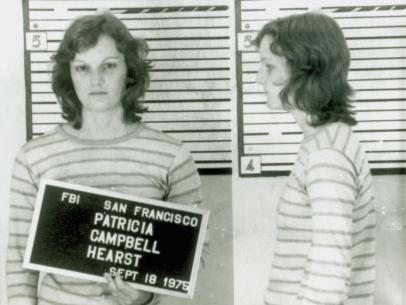An Heiress in the Spotlight
Patty Hearst was no ordinary young woman. Born into one of America’s wealthiest families, she was the granddaughter of media mogul William Randolph Hearst. Her privileged life seemed untouchable—until one night in 1974, when it was shattered in a way that would captivate and confuse the nation for decades.

The Night of the Kidnapping
On February 4, 1974, the 19-year-old college student was abducted from her Berkeley, California apartment by the Symbionese Liberation Army (SLA), a radical left-wing group that had declared war on the U.S. government. The SLA dragged her into their violent world, turning a wealthy heiress into a pawn in their extremist agenda.
Video : Patty Hearst Abduction: Revisiting The Strange Saga Of An American Heiress | TODAY
From Victim to Controversial Figure
Just weeks later, Americans were stunned. Patty reappeared—not as a terrified hostage, but on surveillance footage holding a rifle during an SLA bank robbery in San Francisco. Her transformation from captive to apparent revolutionary left the public divided. Was she brainwashed? A victim of Stockholm syndrome? Or had she willingly embraced the group’s cause?
A Nation Divided by Her Image
The FBI launched one of the largest manhunts of the decade. For 19 months, Hearst lived on the run with the SLA. Posters of her image—armed, defiant, and standing alongside her kidnappers—were plastered across the country. The question on everyone’s mind was simple but haunting: was she a rebel or a victim?

The Trial That Shaped a Generation
In 1975, Patty Hearst was captured by the FBI. Her trial was one of the most sensational in U.S. history. Prosecutors painted her as a criminal, while her defense argued she had been psychologically manipulated, brutalized, and coerced into compliance. In 1976, she was convicted of bank robbery and sentenced to 35 years in prison.
Yet, the debate never ended. Many believed her sentence symbolized the justice system’s failure to understand the psychological effects of captivity.
Mercy, Freedom, and Redemption
In 1979, President Jimmy Carter commuted her sentence after just 22 months behind bars, recognizing the extraordinary circumstances of her case. Two decades later, President Bill Clinton granted her a full pardon in 2001. By then, Patty had rebuilt her life, distancing herself from her past while remaining a cultural symbol of one of America’s most bizarre chapters.
Video : Patty Hearst’s Shocking Words After Robbing a Bank
A Lasting Cultural Legacy
The Patty Hearst saga became more than a news story—it became part of American cultural history. Her case sparked discussions about trauma, coercion, and the thin line between victimhood and complicity. Films, books, and documentaries have since explored her transformation and its broader meaning in an era of political unrest.
Conclusion: The Enduring Mystery of Patty Hearst
Patty Hearst’s story is as complex as it is unforgettable. She began as a kidnapped heiress, was seen as a gun-toting revolutionary, and eventually reclaimed her place as a free citizen. To this day, her name stirs debate: was she merely a pawn of circumstance, or did she willingly cross the line into rebellion?
What’s certain is that her life became one of the most fascinating intersections of wealth, politics, crime, and psychology in modern American history.
